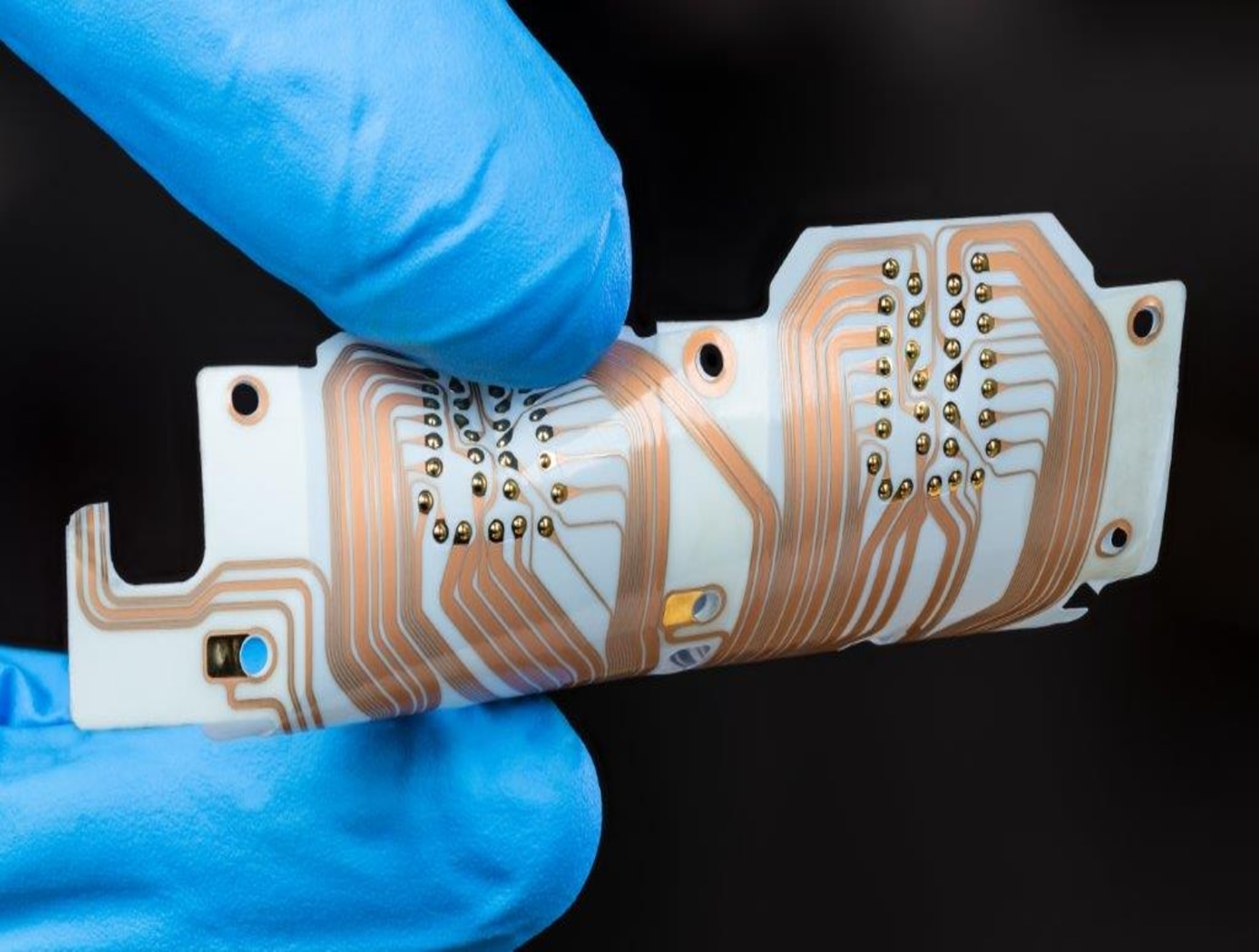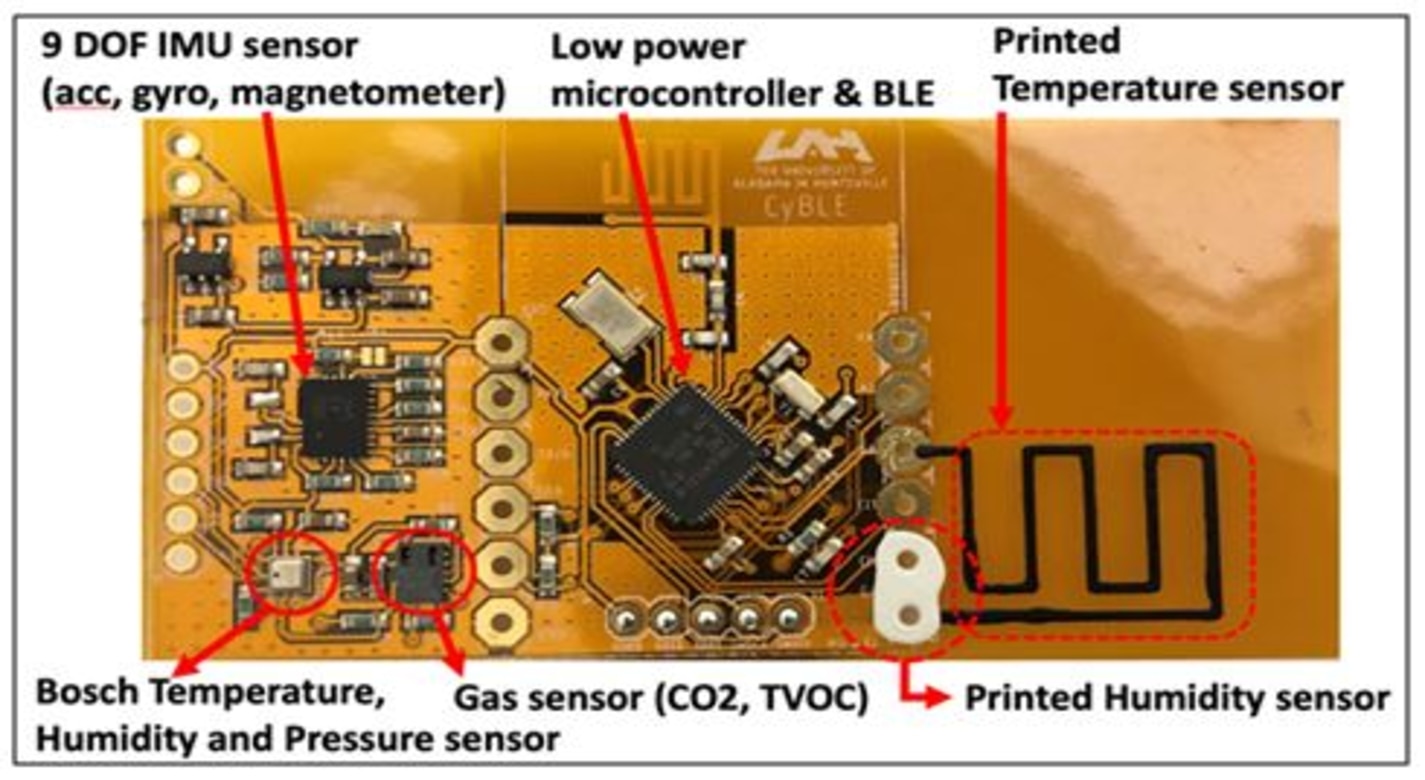Printable IoT sensor development platform
electrical and electronics
Printable IoT sensor development platform (MFS-TOPS-117)
Low-power environmental sensor fusion on a flexible substrate
Overview
NASA inventors have developed a low-power wireless platform for the evaluation of sensors printed on flexible polyimide substrates. The platform simplifies development of novel environmental sensors and their end-use applications by merging Bluetooth low energy (BLE) hardware, sensors, and sensor fusion software. It consists of a printed circuit board with programmable system on a chip (PSoC) microcontroller; commercially available inertial, environmental, and gas sensors; and area for deposition of novel printed sensing elements. Outputs can be configured to send sensor data over BLE connection for recording and analysis in third party software.
The platforms integrated nature reduces system size, cost, and power consumption; it includes all essential hardware to support development of IoT devices. It has been used for development of respiration and environmental monitoring sensors for astronauts aboard the International Space Station.
The Technology
Advances in additive manufacturing have enabled development of printable electronic sensor elements that can be deposited onto flexible substrates. To benchmark performance of printed sensors against the state of the art, NASA developed a low power flexible sensor platform. The platform integrates the following key components and features:
-Flexible substrate: DuPont Kapton allows bending around cylindrical surfaces as small as in diameter.
-Embedded microcontroller: Cypress CY8C4248 LQI-BL583 Arm Cortex M0 processor with BLE wireless controller, max frequency 48 MHz. Supports low power modes of operation, capacitive sensing support, and a single-channel 12-bit AD converter.
-Commercial sensor suite: Bosch BNO080 inertial sensor; Bosch BME280 humidity, pressure, and temperature sensor; AMS CCS811 air quality sensor (VOCs and CO2).
-Prototyping area for custom-printed sensors: 1) thermistor, uses carbon-based PTC resistor paste DuPont2792; 2) capacitive humidity sensor using a NASA-developed dielectric ink.
NASA researchers have used the platform to study performance of the printed capacitive humidity sensor. The 2x4 mm co-doped barium titanate sensing element is highly sensitive to water vapor and performs as an unobtrusive breathing monitor, sensitive to breath at distances of up to 20 cm. Average change of sensor capacitance at a distance of 7.5 cm was observed to be 6.23.5 pF.


Benefits
- Printed sensors: Enables development and characterization of novel printed electronic sensors
- Sensor fusion: Fuses commercial and novel sensor data and streams wirelessly via Bluetooth controller
- Compact Efficiency: Low power consumption, small device suitable for IoT applications
- Flexibility: Device can be bent and adhered to surfaces with small diameters
Applications
- Flexible electronics: development and evaluation platform for printed sensors
- Medical: unobtrusive respiratory monitoring
- Environmental: personal and area wireless gas monitoring
Technology Details
electrical and electronics
MFS-TOPS-117
MFS-34088-1
MFS-33813-1
MFS-33214-1
Long Term Monitoring of Respiration and CO2 using Flexible Printed Sensors. Jovanov et al. 2020 IEEE Aerospace Conference. March 14, 2020.
|
Tags:
|
Similar Results

Wireless Temperature Sensor Having No Electrical Connections
This technology is a new sensor made up of dielectric materials tuned to accurately measure a variable and wide range of temperatures. The sensor is wireless and is powered by an external magnetic field. As the temperature changes, the dielectric material changes its signature magnetic response and the change is detected by a magnetic field response sensor. Applications for this technology are temperature sensors for non-conductive surfaces where the conditions or operations require a robust and wireless sensor.

RFID-Enabled Wireless Instrumentation
With a form factor close to a deck of playing cards, the system interrogator has custom software to interface with and service a population of sensor tags at the required data rates. Each EPCglobal C1G2 sensor tag uses incident interrogator energy to charge its small integrated circuit (IC), which reads an internal memory bank, encodes identification data, and uses that information to modulate and backscatter a reply to the interrogator using reflected interrogator energy. Two tag interfaces allow the attached processor to power the reading/writing of data to the tag memory and then allows the interrogator to power the reading of the tag memory data. When neither of the two interfaces are engaged, the RFID IC is completely powered down. Reading and writing tag memory consumes relatively little power compared to the power draw of active transmitter/receiver protocols like Bluetooth, Zigbee, and Wi-Fi. Compared to passive sensing protocols, this wireless instrumentation system enables sampling of a larger population of tags without the computational burden associated with surface acoustic wave (SAW) sensing. RFID-Enabled Wireless Instrumentation technology allows the RFID interrogator to write data through the interface of a sensor tag memory bank using only interrogator power. With only minimal cost to the sensors power budget, the microcontroller unit can read that data out over the serial interface. The sensor can transmit and receive data at no effective cost to its small coin cell battery power supply.
This technology is readiness level (TRL) 8 (actual system completed and "flight qualified" through test and demonstration) and the innovation is now available for your company to license. Please note that NASA does not manufacture products itself for commercial sale.

Polymer Electrolyte-Based Ambient Temperature Oxygen Microsensor
Conventional ambient-temperature oxygen sensors are limited in various ways: optically based sensors can be expensive and challenging to manufacture; electrochemical cells with liquid electrolytes can have limited lifetimes and become leak sources; and both types of sensors are difficult to miniaturize. These problems are addressed with Glenn's novel ambient temperature oxygen microsensor, which is based on a Nafiontm polymer electrolyte, microfabricated using thin-film technologies. In the past, one drawback of Nafiontm film has been that it can lose conductivity when the moisture content in the film is too low, potentially affecting sensor operation. Glenn researchers devised a method to use certain salts to hold water molecules in the Nafiontm film structure at room temperature. The presence of these salts provides extra sites in the film to promote proton (H+) mobility, thus improving film conductivity and overall sensor performance, particularly in arid and high-temperature environments.
The innovative use of metal/metal oxide as the reference electrode enables miniaturization by eliminating the reference gas and sealing the reference electrode. The combination of interdigitized electrodes with the unique metal/metal oxide reference electrode permits sensor operation in either potentiometric or amperometric mode, as appropriate. In potentiometric mode, which measures voltage differences between working and reference electrodes in different gases, the voltage differences can be monitored with a voltmeter; however, the sensor itself does not need a power source. In room-temperature testing, the sensor achieved repeatable responses to 21 percent oxygen in nitrogen (using nitrogen as a baseline gas), and also detected oxygen from 7 to 21 percent, making Glenn's breakthrough technology usable for personal health monitoring as well as fire detection, fuel-leak detection, and environmental monitoring.

Low-Profile Wireless Sensor
The low-profile sensor is configured with a spiral electrical trace on flexible substrate. In typical inductor designs, the space between traces is designed to minimize parasitic conductance to reduce the impact of the capacitance to neighboring electronics. In the low-profile sensor, however, greater capacitance is desired to allow the operation of an inductor-capacitor circuit. This allows the traces to be closer together, decreasing the
overall size of the spiral trace.
The sensor receives a signal from the accompanying magnetic field data acquisition system. Once electrically active, the sensor produces its own harmonic magnetic field as the inductor stores and releases magnetic energy. The antenna of the measurement acquisition system is switched from a transmitting to a receiving mode to acquire the magnetic-field response of the sensor. The magnetic-field response attributes of frequency, amplitude, and bandwidth of the inductor correspond to the physical property states measured by the sensor. The received response is correlated to calibration data to determine the physical property measurement. When multiple sensors are inductively coupled, the data acquisition system needs to activate and read
only one sensor to obtain measurement data from all of them.

Wireless Chemical Sensor
The SansEC sensor is an open circuit without electrical connections, which functions as an electrical simple harmonic oscillator when exposed to a harmonic magnetic field. Its response is dependent upon the measured physical property. It consists of a uniquely designed thin-film electrically conductive geometric pattern that stores energy in both electric and magnetic fields. When wirelessly interrogated using the NASA developed Magnetic Field Response Recorder (U.S. Patent Number 7,159,774), the sensor becomes electrically active, and a chemical reactant works in tandem with the thin-film trace. If the chemical is present, it causes a change to the reactant, resulting in an alteration to the sensors magnetic field response attributes. This change is noted electronically by the Magnetic Field Response Recorder.



